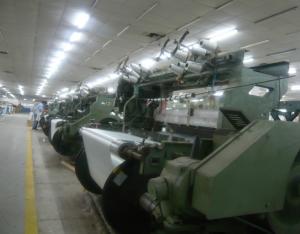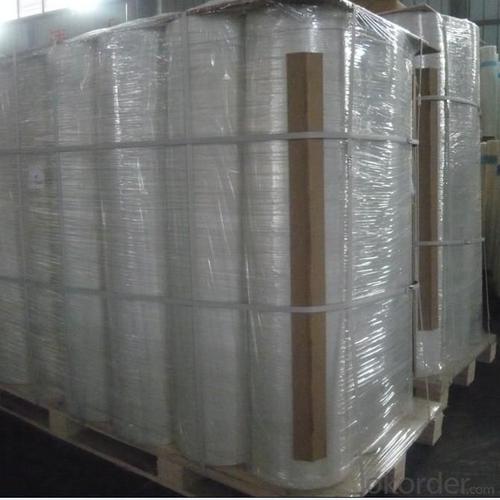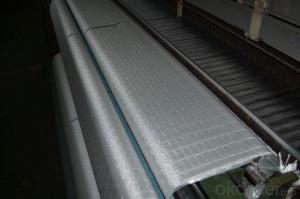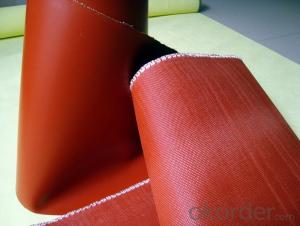Multi-Axial Fiberglass Fabrics Manufacturing
- Loading Port:
- Shanghai Port
- Payment Terms:
- TT or LC
- Min Order Qty:
- 10000 M2 m²
- Supply Capability:
- 50000000 M2 Per Year m²/month
OKorder Service Pledge
OKorder Financial Service
You Might Also Like
Introduction of Multi-axial Fiberglass Fabric:
E-Glass multiaxial fiberglass fabric is made of e-glass direct roving parallel aligned in 0º, 90º, +45º, -45º, then stitched with or without a layer of chopped strand mat.
Each layer is typically oriented in one of four directions; Standard configurations offered by multiaxial fabric suppliers include biaxial(0º, 90º), double bias(+45º, -45º), triaxial.
Fiberglass Biaxial Fabric for hand lay-up process Glass fiber Multiaxial Fabric warp(0º, +45º, -45º), triaxial weft(90º, +45º, -45º) and four axial (0º, 90º, +45º, -45º).
It’s compatible with UP, Vinyl Ester and Epoxy etc, used in GRP pultrusion process, hand lay-up process and RTM process etc, out-made products include GRP boats, automobile parts, wind energy bl E-ades etc.
Advantages of Multi-axial Fiberglass Fabric:
Mechanical property of different directions is adjustable.
The multi-layers structure could simplify forming process, improve operation efficiency.
Quickly wet-out, good molding property, easily to delete air bubbles.
Specification of Multi-axial Fiberglass Fabric:
Specs | 0ºg/m2 | 90º | +45º | -45º | Mat | Total Weight |
| EMF400/800(0º, 90º) | 400 | 400 | 400 | 1200 | ||
| EMF1200(0º, +45º, -45º) | 400 | 400 | 400 | 1200 | ||
| EMF800(0º, 90º, +45º, -45º) | 200 | 200 | 200 | 200 | 800 | |
| EMF450/800(0º, 90º, +45º, -45º) | 200 | 200 | 200 | 200 | 450 | 1250 |
Packing of Multi-axial Fiberglass Fabric:
Each roll is packed in a polyethylene bag inside, then outside with a cardboard box, then on pallet.
Storage of Multi-axial Fiberglass Fabric
In dry and cool places. The best condition is with temperature between 15°C and 35°C, with a relative humidity between 30% and 70%. Before use, please keep it in original package

- Q: How does fiberglass fabric perform in corrosive environments in chemical plants?
- Fiberglass fabric is well-known for its excellent performance in corrosive environments in chemical plants. It is highly resistant to a wide range of corrosive chemicals, making it an ideal choice for various applications in these harsh environments. One of the primary reasons fiberglass fabric is effective in corrosive environments is its inherent non-reactivity to most chemicals. It does not corrode or degrade when exposed to acids, alkaline substances, or other aggressive chemicals commonly found in chemical plants. This non-reactivity ensures the fabric's integrity and longevity, as it remains unaffected even after prolonged exposure to corrosive agents. Additionally, fiberglass fabric has a high strength-to-weight ratio, making it capable of withstanding mechanical stresses in corrosive environments. It retains its structural integrity even when exposed to extreme temperature variations, pressure changes, or physical impacts. This durability makes it suitable for use in applications such as lining tanks, pipes, or vessels, where it can help contain corrosive substances without suffering any significant degradation. Furthermore, fiberglass fabric exhibits excellent electrical insulation properties, which is crucial in chemical plants where electrical equipment and wiring are commonly exposed to corrosive chemicals. The fabric acts as a barrier, preventing corrosive substances from coming into contact with electrical components, thereby minimizing the risk of electrical failures or accidents. Lastly, fiberglass fabric is also fire-resistant, providing an additional layer of safety in chemical plants where flammable substances are present. It has a high melting point and does not support combustion, making it suitable for applications that require fire resistance. Overall, fiberglass fabric is an exceptional choice for corrosive environments in chemical plants due to its non-reactivity to chemicals, high mechanical strength, electrical insulation properties, and fire resistance. Its ability to withstand harsh conditions while maintaining its integrity makes it a reliable and long-lasting solution for various applications within the chemical industry.
- Q: Can fiberglass fabric be used for gaskets and seals?
- Certainly, gaskets and seals can be made using fiberglass fabric. Renowned for its ability to withstand high temperatures, durability, and exceptional insulation properties, fiberglass fabric is an ideal material for manufacturing gaskets and seals across a range of industries such as automotive, aerospace, industrial, and marine. By utilizing this fabric, one can fashion customized gaskets and seals that possess a snug and secure fit, effectively averting any fluid or gas leakage. Moreover, fiberglass fabric exhibits remarkable resilience when confronted with harsh chemical conditions, rendering it a dependable option for gaskets and seals that must endure exposure to corrosive substances.
- Q: The thickness of the stone concrete protection layer on the waterproof layer shall not be less than mm.
- The waterproof layer is arranged and standardized construction methods: to brush 2~3 times, otherwise it should add the glass cloth, and the cured thickness of each brush shall not be less than 1 mm, and should be completely dry (about 5-8 hours) and then again under construction. After brushing, should also be on the coating waterproof layer, and then do a mortar protection layer, and finally paste ceramic tile.
- Q: Can fiberglass fabric be used for insulation in data centers?
- Yes, fiberglass fabric can be used for insulation in data centers. Fiberglass fabric is known for its excellent thermal insulation properties, making it a suitable choice for insulating data centers. It helps in maintaining a stable temperature within the data center, preventing heat from escaping during cold weather and preventing excessive heat buildup during hot weather. Additionally, fiberglass fabric is also fire-resistant, which is crucial in data centers where the risk of fire can be high due to the presence of electrical equipment. Overall, fiberglass fabric provides effective insulation and contributes to the energy efficiency and safety of data centers.
- Q: Is fiberglass fabric resistant to moisture in marine environments?
- Yes, fiberglass fabric is highly resistant to moisture in marine environments. It is a popular choice for marine applications due to its excellent water repellent properties. The fiberglass fabric is made from fine strands of glass fibers that are woven together, creating a strong and durable material. These fibers do not absorb water, ensuring that the fabric remains resistant to moisture even when exposed to harsh marine conditions. This resistance to moisture makes fiberglass fabric ideal for use in marine applications such as boat covers, sails, and other marine equipment where protection from water is essential. Additionally, fiberglass fabric is also resistant to the growth of mold and mildew, which further enhances its suitability for marine environments.
- Q: What is the "three proof cloth"? How to correctly use the three proof cloth?
- Three proof cloth is PVC coated glass fiber cloth.
- Q: Is fiberglass fabric resistant to chemicals in chemical processing plants?
- Yes, fiberglass fabric is highly resistant to a wide range of chemicals commonly found in chemical processing plants. It is known for its excellent chemical resistance, making it a suitable choice for various applications in the industry.
- Q: How does fiberglass fabric perform in water repellency?
- Fiberglass fabric performs exceptionally well in terms of water repellency. The fabric is made from woven glass fibers, which are naturally hydrophobic in nature. This means that water molecules are unable to penetrate the fabric easily, resulting in excellent resistance to water absorption. The hydrophobic properties of fiberglass fabric make it ideal for applications where water repellency is crucial, such as in the production of outdoor clothing, tents, and boat covers. When exposed to water, the fabric remains relatively dry and does not become heavy or waterlogged. Additionally, the construction of fiberglass fabric allows it to maintain its water repellency over time. The fabric does not easily lose its hydrophobic properties, even after repeated exposure to water or washing. This durability makes fiberglass fabric a reliable choice for applications where long-term water resistance is required. However, it is important to note that while fiberglass fabric is highly resistant to water absorption, it is not completely waterproof. In extreme conditions, such as heavy rain or prolonged submersion, some water may eventually seep through the fabric. Nonetheless, fiberglass fabric still outperforms many other materials in terms of water repellency and remains a popular choice in various industries.
- Q: Does fiberglass fabric shrink?
- Yes, fiberglass fabric can shrink under certain conditions, such as exposure to high temperatures or excessive stretching.
- Q: Can fiberglass fabric be used for reinforcement in boat decks?
- Yes, fiberglass fabric can be used for reinforcement in boat decks. Fiberglass fabric is known for its strength, durability, and resistance to corrosion, making it an ideal material for boat construction. It can add structural integrity to boat decks, providing reinforcement and enhancing their overall strength. Additionally, fiberglass fabric is lightweight, which is advantageous for boats as it helps to maintain buoyancy and fuel efficiency. Furthermore, fiberglass fabric is highly resistant to water and weather conditions, making it suitable for marine environments. Overall, fiberglass fabric is a popular choice for reinforcing boat decks due to its strength, durability, corrosion resistance, and lightweight properties.
1. Manufacturer Overview
| Location | Shandong, China |
| Year Established | 2002 |
| Annual Output Value | Below US$1 Million |
| Main Markets | North America; South America; Eastern Europe; Southeast Asia; Africa; Oceania; Mid East; Eastern Asia; Western Europe; Central America; Northern Europe; Southern Europe; South Asia |
| Company Certifications | ISO 9001:2000 |
2. Manufacturer Certificates
| a) Certification Name | |
| Range | |
| Reference | |
| Validity Period |
3. Manufacturer Capability
| a) Trade Capacity | |
| Nearest Port | Qingdao Port |
| Export Percentage | 81% - 90% |
| No.of Employees in Trade Department | Above 10 People |
| Language Spoken: | English; Chinese; |
| b) Factory Information | |
| Factory Size: | Above 10,000 square meters |
| No. of Production Lines | Above 10 |
| Contract Manufacturing | Design Service Offered; Buyer Label Offered |
| Product Price Range | High; Average |
Send your message to us
Multi-Axial Fiberglass Fabrics Manufacturing
- Loading Port:
- Shanghai Port
- Payment Terms:
- TT or LC
- Min Order Qty:
- 10000 M2 m²
- Supply Capability:
- 50000000 M2 Per Year m²/month
OKorder Service Pledge
OKorder Financial Service
Similar products
Hot products
Hot Searches
Related keywords



























